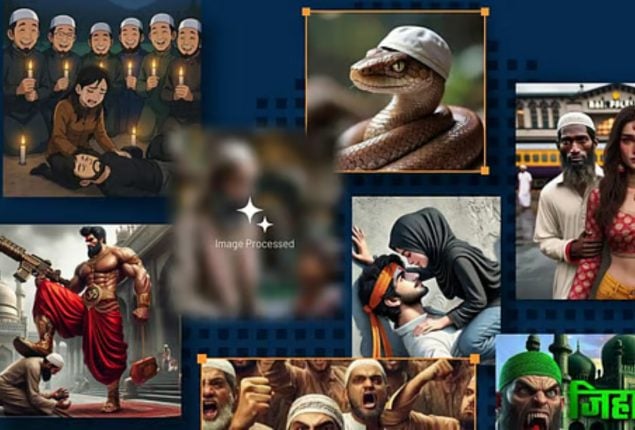
AI-generated
A new report by the Centre for the Study of Organised Hate (CSOH) has revealed an alarming surge in the use of AI-generated imagery to spread Islamophobic narratives across India’s digital platforms.
Authored by Nabiya Khan, Aishik Saha, and Zenith Khan, the report examines how artificial intelligence tools are being exploited to craft and circulate visual hate content that targets Muslims, reinforcing stereotypes and deepening social divides.
While numerous studies have previously documented Islamophobia online, the authors note that AI-generated visuals specifically designed to dehumanise Muslims have received little scholarly or policy attention.
The study analysed 1,326 AI-generated Islamophobic posts shared between May 2023 and May 2025 from 297 public accounts on various social media platforms, each generating significant engagement.
According to the findings, the hateful imagery largely falls into four categories:
The sexualisation of Muslim women, exclusionary and dehumanising portrayals, conspiratorial narratives, and the aestheticisation of violence.
With an estimated 22 million AI users in India, the report warns that such tools have become powerful amplifiers of hate, targeting religious minorities and Dalit communities through digitally manipulated content.
Co-author Nabiya Khan noted that far-right media networks and online groups use these AI-generated visuals as “amplifiers” to flood social media with Islamophobic messages.
“These tools make old prejudices scalable — they’re faster, cheaper, and harder to trace. Current laws are insufficient to govern or regulate this type of content,” she told Maktoob Media.
The report cites examples such as the Assam BJP’s Islamophobic video depicting a dystopian future and viral WhatsApp forwards, illustrating how digital propaganda has become increasingly sophisticated.
One of its central conclusions is that AI is not creating new hate, but automating existing hate. The imagery frequently depicts Muslims as inherently violent, including disturbing portrayals such as snakes wearing skull caps — visuals that symbolically portray Muslims as “deceptive and dangerous.”
Other AI-generated images adopt anime or Ghibli-style aesthetics, or appear under humour-based hashtags, making them seem harmless and harder to identify as hate speech.
Particularly alarming are the sexualised depictions of Muslim women, which garnered 6.7 million interactions, reflecting how misogyny and anti-Muslim hate intertwine in online spaces. These visuals often dehumanise Muslim men as hypersexual predators and depict Muslim families as morally corrupt, the report adds.
The study also found widespread use of conspiratorial themes like “love jihad,” “population jihad,” and “rail jihad” — framing Muslims as threats to Hindu national identity. Such narratives, the authors warn, enable political actors to mobilise hate without accountability or fact-checking.
The report concludes with a call for greater digital literacy and critical engagement from the public.
“People must learn to question the intent behind such images and ask, who benefits from me believing this?” Khan emphasised.
Read More News On
Catch all the International News, Breaking News Event and Latest News Updates on The BOL News
Download The BOL News App to get the Daily News Update & Follow us on Google News.




